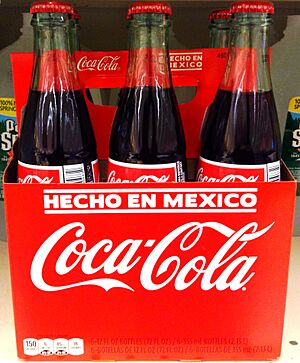Mexican Coke facts for kids

Bottle of imported Mexican Coca-Cola
|
|
| Owner | The Coca-Cola Company |
|---|---|
| Introduced | 1921 |
Mexican Coca-Cola, often called "Mexican Coke" or "Mexicoke," is a special version of Coca-Cola that comes from Mexico. It's popular in the United States. The main difference is how it's sweetened. Mexican Coke uses real cane sugar, while the Coca-Cola made in the U.S. has used high-fructose corn syrup since the 1980s. Some people think Mexican Coke tastes better, but others can't tell the difference in blind tasting tests.
Contents
The Story of Mexican Coke
The Coca-Cola Company started bottling its drinks in Mexico around 1921. Companies like Grupo Tampico and Grupo ARMA were among the first to bottle Coca-Cola there. Today, a company called FEMSA, based in Monterrey, is the biggest Coca-Cola bottler in Mexico and much of Latin America.
In the United States, high-fructose corn syrup became a cheaper way to sweeten drinks than regular sugar. This was because of rules about how much sugar could be made in the U.S. and taxes on sugar brought in from other countries. The Coca-Cola Company and other soda makers in the U.S. started using high-fructose corn syrup in 1980 and fully switched by 1984. However, they kept using sugar in other countries.
How Mexican Coke Became Popular
The Coca-Cola Company first brought Mexican Coke into the U.S. for Mexican immigrants. These people had grown up drinking the sugar-sweetened version. At first, you could only find Mexican Coke in stores that served Latino customers. But it became so popular with other people too. By 2009, big stores like Costco, Sam's Club, and Kroger started selling it. Now, you can find it in many grocery stores across the United States.
In 2013, a company that bottles Mexican Coca-Cola said it might stop using cane sugar. This was to follow new food labeling rules in Mexico. But they later made it clear that bottles sent to the U.S. as "Coca-Cola Nostalgia" products would still use cane sugar.
Does Mexican Coke Taste Different?
People have different opinions on whether Mexican Coke tastes better. In one taste test, some people said Mexican Coke had a "more complex flavor." They even noticed a slight spicy or herbal taste. However, in other tests, people preferred American Coca-Cola. Some double-blind tests, where neither the tasters nor the people giving the drinks knew which was which, found no real difference in taste.
The Special Bottle
Mexican Coca-Cola often comes in a thick glass bottle. These bottles are usually 355 ml or 500 ml. Many people think these glass bottles look "more elegant" and bring back old memories compared to the plastic bottles used for American Coca-Cola. In the past, Coca-Cola was sold in glass bottles in the U.S. too. But in the late 1980s, most companies switched to plastic bottles.
Mexican Coke bottles sold in the U.S. usually have a paper sticker. This sticker has the nutrition facts, ingredients, and contact information. This is needed to meet U.S. food labeling rules. Also, the glass bottles of Mexican Coke often have a cap that you need an opener for, not a twist-off cap like plastic bottles. This adds to the feeling of nostalgia for many people.
Similar Drinks Around the World
A similar thing happens in New Zealand. There, you can buy Coca-Cola that is bottled locally with cane sugar. You can also find Coca-Cola imported from the United States, which uses high-fructose corn syrup.
Kosher for Pesach Coke
Another special version of Coca-Cola is made in Israel for the Jewish holiday of Pesach. During this holiday, Jewish dietary law says that people cannot eat grains or grain products. So, the corn syrup in regular Coke is replaced with cane sugar for these special bottles. You can spot them by their yellow bottle caps. The labels are written in both Hebrew and English. This special "Kosher for Pesach" Coke is sent to other countries and can often be found in American kosher supermarkets around Passover.
See also
 In Spanish: Coca Cola de vidrio para niños
In Spanish: Coca Cola de vidrio para niños
- Pepsi-Cola Made with Real Sugar, a line of Pepsi products flavored with cane sugar


